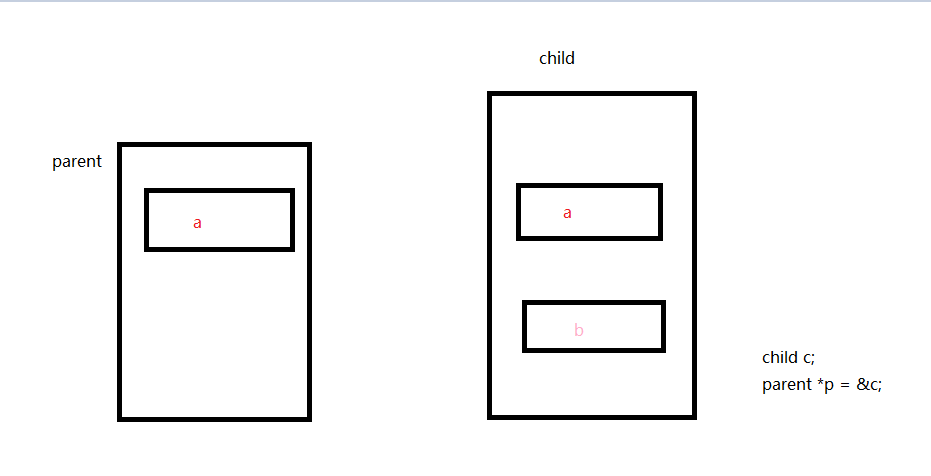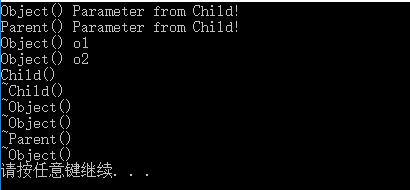1.继承
class Student
{
public:
Student()
{
}
Student(int id, string name)
{
this->id = id;
this->name = name;
}
void printS() {
cout << "id = " << this->id << ", name = " << this->name << endl;
}
int id;
string name;
};
//通过继承创建一个新的学生类
class Student2 :public Student
{
public:
Student2(int id, string name, int score) :Student(id, name) //调用父类构造函数
{
this->score = score;
}
void printS() {
Student::printS();
cout << "score = " << this->score << endl;
}
private:
int score;
};
private成员在子类中依然存在,但是却无法访问到。不论何种方式继承基类,派生类都不能直接使用基类的私有成员 。

父类指针可以指向子类对象
void myPrint(parent *p)
{
}
myPrint(&p);
myPrint(&c);

父类、子类出现重名变量
class Parent
{
public:
Parent(int a) {
this->a = a;
}
int a;
};
class Child :public Parent
{
public:
Child(int p_a, int c_a) :Parent(p_a)
{
this->a = c_a;
}
void print()
{
cout << Parent::a << endl;
cout << this->a << endl;//child's a
}
int a;
};
继承中构造和析构
先构造父类,再构造成员变量、最后构造自己
先析构自己,在析构成员变量、最后析构父类
class Object
{
public:
Object(const char* s)
{
cout<<"Object()"<<" "<<s<<endl;
}
~Object()
{
cout<<"~Object()"<<endl;
}
};
class Parent : public Object
{
public:
Parent(const char* s) : Object(s)
{
cout<<"Parent()"<<" "<<s<<endl;
}
~Parent()
{
cout<<"~Parent()"<<endl;
}
};
class Child : public Parent
{
public:
Child() : o2("o2"), o1("o1"), Parent("Parameter from Child!")
{
cout<<"Child()"<<endl;
}
~Child()
{
cout<<"~Child()"<<endl;
}
private:
Object o1;
Object o2;
};
void run()
{
Child child;
}
int main(int argc, char *argv[])
{
run();
return 0;
}

2.多继承、虚继承

//家具类
class Furniture
{
public:
int m; //材质
};
//将父亲类继承爷爷类 改成虚继承, 防止儿子在多继承的时候,出现爷爷中的变量会拷贝多份。
class Bed:virtual public Furniture
{
public:
void sleep() {
cout << "在床上睡觉" << endl;
}
};
class Sofa:virtual public Furniture
{
public:
void sit() {
cout << "在沙发上休息" << endl;
}
};
//沙发床
class SofaBed :public Bed, public Sofa
{
public:
void SleepAndSit() {
sleep();
sit();
}
};









